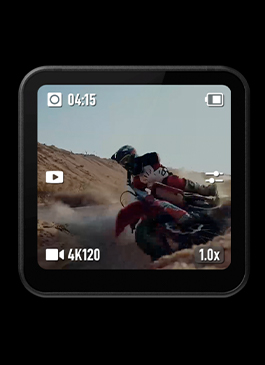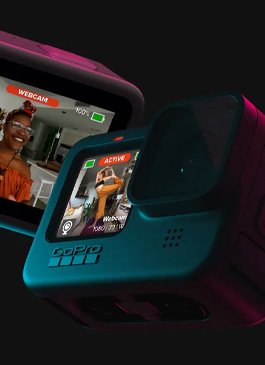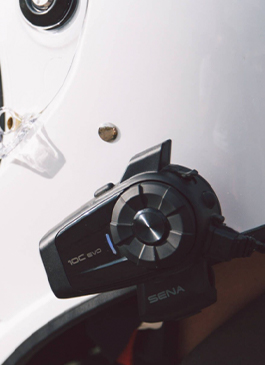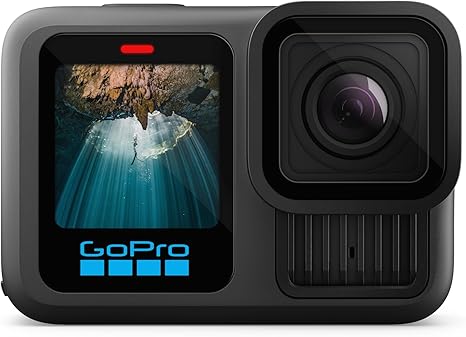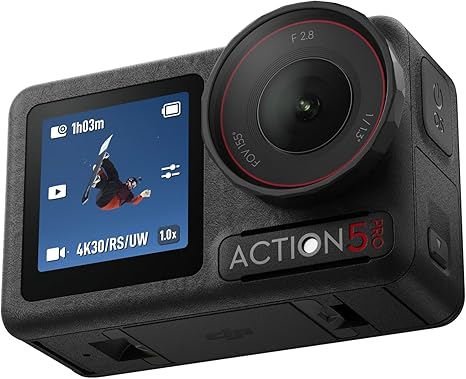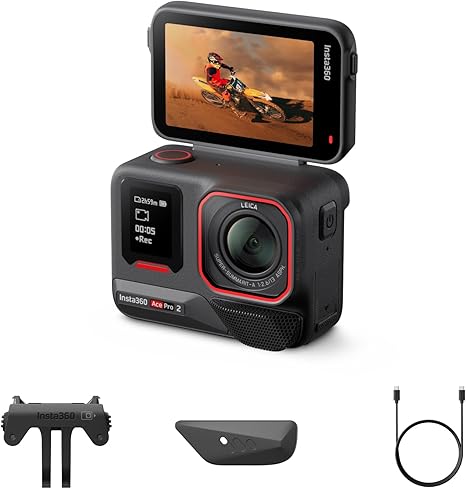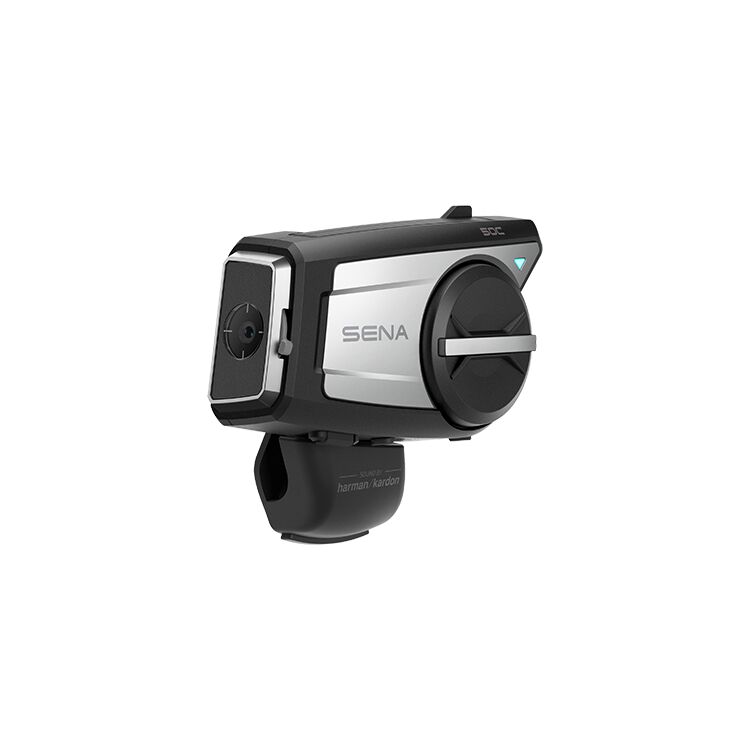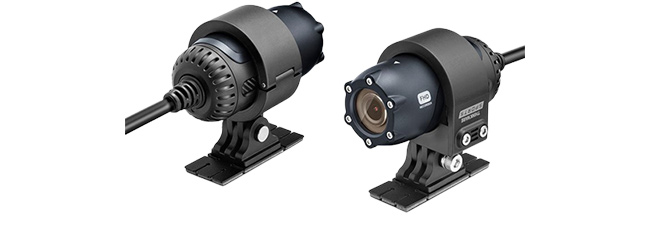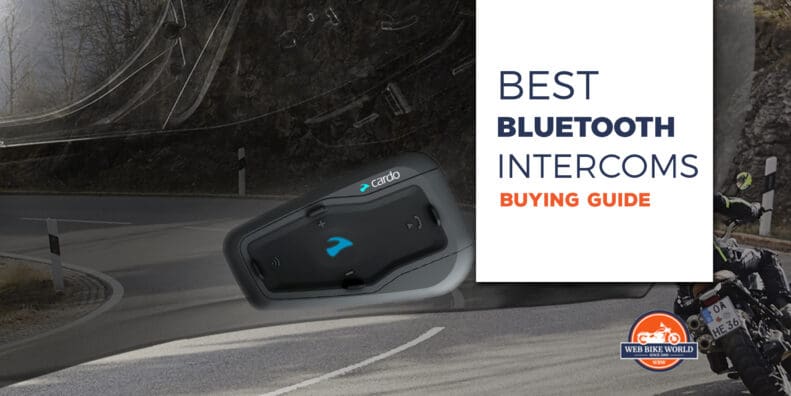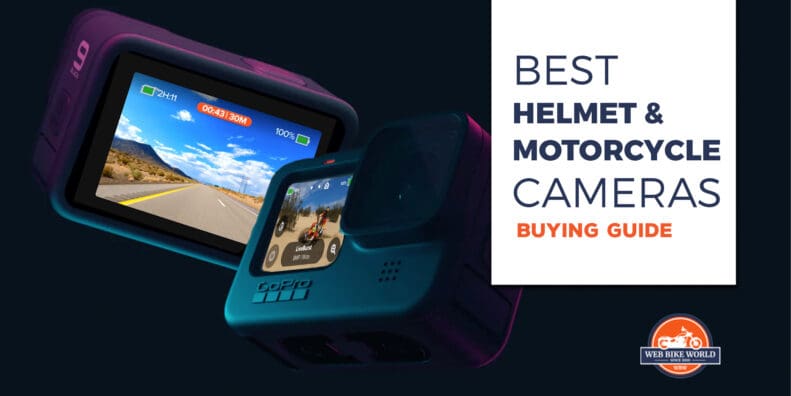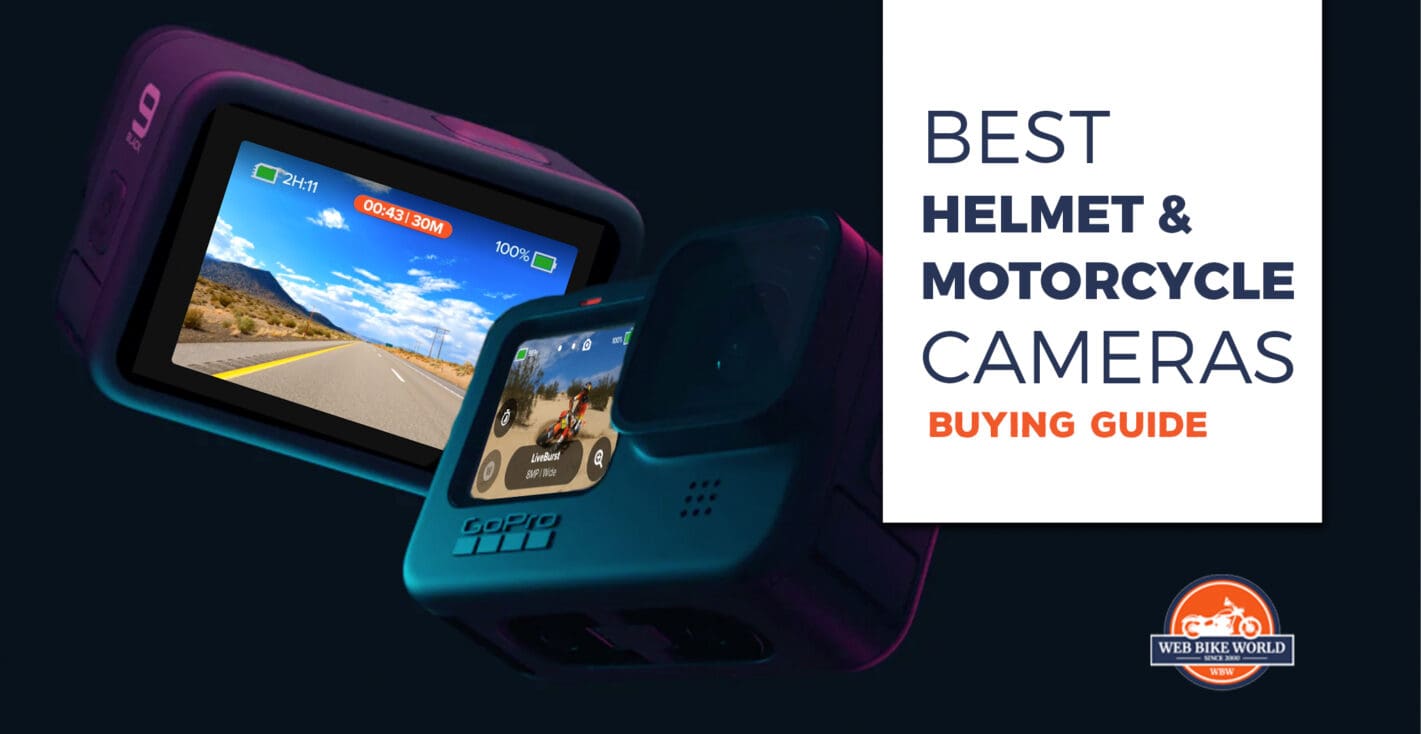
The Best Helmet & Motorcycle Cameras for 2025
We’d Know: We’ve Hands-On Tested 150+ Intercoms & Riding Cameras
Our picks are based on cameras that offer the best blend of safety/performance, function/features, and price.
Last updated February 2025 by Devan Martel
Helmet vs. Motorcycle-Mounted Cameras
Whether you want to venture into motovlogging or have video to back up potential insurance claims, helmet and motorcycle-mounted cameras are becoming increasingly popular. There are solutions out there that will fit almost any helmet or bike, and almost all of them will capture video in at least 1080p resolution.
One thing that is important to note is that helmet cameras and bike-mounted cameras are two entirely different beasts:
Helmet cams are almost exclusively powered by lithium-ion batteries built into them, and can be quickly mounted and dismounted.
Bike-mounted cameras, on the other hand, are either action cameras with batteries that can be changed out, or hardwired solutions that pull power directly from the bike itself to operate.
The other major distinction between the two is that helmet cameras will capture where you look, while a bike-mounted camera, with the exception of a 360-degree spherical capture camera, will only capture where it is pointed. This is relevant because in many insurance cases involving sideswipes or being rear-ended while in motion, proof that you performed a shoulder check and signaled before changing lanes could be the determining factor in your case.
About Our Recommendations
Founded in 2000, our team at wBW has collectively tested more than 150 motorcycle cameras and intercoms, alongside more than 2,500 helmets, jackets, boots, gloves, and accessories. We do not fluff reviews. A riders safety is heavily dictated by how they ride and what they wear while doing so. Our goal is to help riders make informed decisions about the gear they invest in to protect themselves.
While there are a lot of solutions out there, we’ve put together this list of the current best options for both helmet-mounted cameras and bike-mounted cameras as of August 2022. We are not setting a budget cap for this list — sometimes, to get the best, you have to shell out a little more. With that in mind, and in no particular order, these are the cameras we recommend!
wBW is funded by our audience. Our recommendations and reviews may contain affiliate links that earn us a small comission if you make a purchase after clicking them. This is the primary way we fund our website and pay our review team (and comes at no additional cost to you). We disclose our relationship with brands or manufacturers for transparency. For more information about our extensive review process, see our review policies.
Motorcyle Action Cameras
Can be both helmet or motorcycle mounted.
GoPro Hero13 Black
Price: Up to $400
Where to buy: Amazon
Why?
Everyone knows GoPro - the official camera of thrill seekers everywhere. The hero series has had a long reign as the leading action camera on the market, and now that its in its 13th iteration, we don’t see that reputation changing. GoPro somehow just manages to improve time and time again.
Longer battery life, compatibility to do on-device noise cancelling from a microphone mounted in your helmet, electronic stabilization, and a fairly universal mounting kit all just add to the value of using a GoPro on your helmet.
More Hero13 Black Details
The Hero13 Black is capable of up to 5.3K video at 60fps, with a huge variety of different shooting modes we can almost guarantee the Hero13 will get the job done for nearly any video you have in mind, whether it be urban cruising or tearing up the track.
The GoPro is renowned for its extreme durability and now features waterproofing up to 33 ft, and a hydrophobic lens, which should keep shots nice and clear during rainy rides, or if you intend to use your camera for activities besides biking.
GoPro’s image stabilization software is so advanced and impressive it’s won an Emmy Award for “In Camera Sensor and Sofware Stabilization” - a category we didn't even know existed, that said, we're sure that if the software is award-winning, it should be able to take whatever you throw at it, no matter how hard you ride.
Another cool feature? The GoPro Hero13 is capable of shooting Slo-Mo footage at 400 FPS!
DJI Osmo Action 5 Pro
Price: Up to $449
Where to buy: Amazon
Why?
DJI has been a household name for a couple of years now thanks to their stellar drone products in both the consumer & professional markets, however, many people aren't aware that DJI also produces various other cameras, including a line of action cameras that rival GoPro like nobody else has before.
The DJI Osmo Action line, now on its 5th iteration, packs a lot of great features into a tiny frame and gives great bang for your buck. Available 4K/120fps footage provides for some absolutely beautiful shots, and you can rest assured that they will be stable thanks to DJI’s RockSteady 3.0 & HorizonSteady software.
More Osmo Action 4 Details
A 1/1.3-inch sensor allows every adventure to be caught in great detail, no matter the lighting you’re filming in. The camera can operate properly at as low as -4°F (-20°C), which is a little chilly for riding in our opinion, but it’s good to know you can repurpose the camera for other sports during the colder months. The DJI Osmo Action 5 Pro has a MASSIVE battery life that is good for up to 4 hours!
For mounting, the Action 5 Pro uses a strong magnetic quick-release system, which is widely considered to be comparable to a solid GoPro mounting system, but with fewer moving parts to keep track of. The camera uses dual full-colour touch screens which make it a breeze to review footage on the fly.
Insta 360 Ace Pro 2
Price: $400
Where to buy: Amazon
Why?
Insta360 makes some pretty cool gear capable of 360-degree video - a feature that can be useful for unique shots, but also as a safety feature if you use your camera as a dashcam.
While the Ace Pro 2 isn't capable of 360-degree-video, it is capable of shooting in 8k30FPS video! Never before will you have been able to capture such stunning footage while on the go.
The camera is also the first to incorporate a dual AI chip for superior noise reduction, image processing and superior performance. The chip is said to deliver 100% more computing power than the previous model Insta360 Ace Pro.
More Insta 360 Ace Pro 2
The Insta 350 Ace Pro 2 makes use of a 2.5" flip touchscreen for easy use when you have the camera pointed at yourself. The screen makes staging your shot seamless when mounted on your handlebars, or when shooting vlog style.
Another improvement over the previous generation is 4K50FPS active HDR video. This improvement unlocks a powerful dynamic range, with better light and shadows throughout any shot.
Helmet-Mounted Cameras
These attach to the side of your helmet.
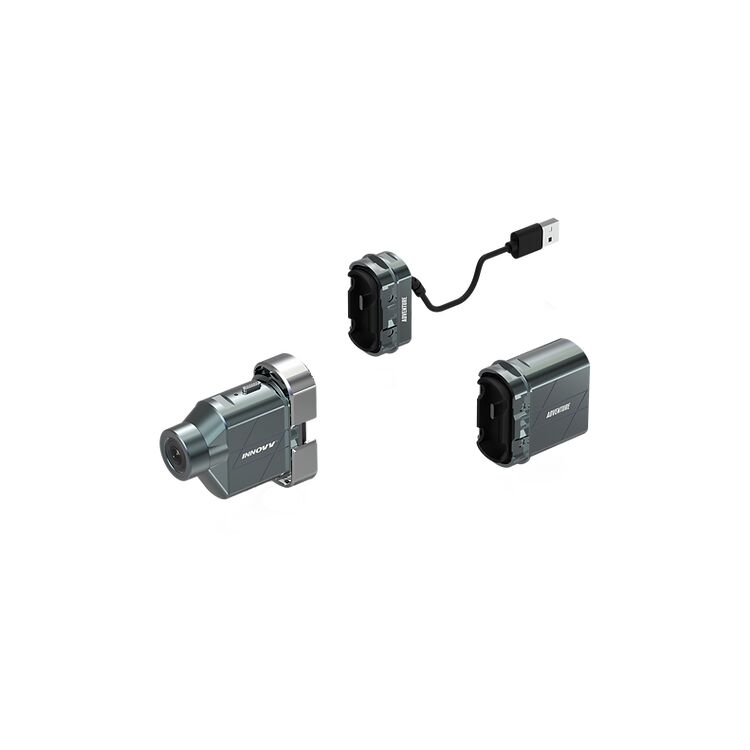
INNOVV H5 Helmet Cam
Price: $268
Where to buy: RevZilla
Why?
The H5 is a powerful helmet mounted camera for any motorcyclist looking to record POV footage of their ride. It's capable of recording 4K at 30PS, with a EIS image stabilization feature to ensure smooth, clear image.
The battery life is exceptional, with up to 5 hours of recording time while the auxiliary power supply can offer an option for even longer battery life. The unit is weather-resistant IP65 so you can use it rain or shine.
More INNOVV H5 Helmet Cam
The INNOVV H5 Helmet cam has a maximum storage capacity of 512GB (using a microSD card that is sold separately). It is recommended to use a U3 (UHS Speed Class 3) high-speed class memory card to achieve true 4K UHD recording
As mentioned, the camera is equipped with a Electronic Image Stabilization technology that ensures a high resolution 4K image in rapid motion environments. It works by actively compensating for blur and rotation, as well as eliminating unnecessary vibrations.
SENA 50C
Price: Up to $550
Where to buy: RevZilla
Why?
SENA is, along with Cardo, one of the two “Big Boys” of motorcycle Bluetooth communication units. While Cardo focuses entirely on the comms side of things, SENA has started pairing some of their recent comms units with HD cameras to give you the best of both worlds.
The 50C system combines a premium comms setup, featuring Harman Kardon speakers, with a 4K camera - it really doesn't get better than that.
More 50C Details
The Sena 50C is a class-leading comms system in every sense of the word. Features like Harman Kardon Premium Speakers, Integrated Mesh & Bluetooth Intercom systems,and Voice-Activated Digital Assistant Access (Google, Siri, etc) make it extremely easy to see how this piece of equipment would be an excellent addition to any riding setup.
The integrated camera is capable of shooting video in 4K @ 30FPS - not the best specs on this list, but absolutely nothing to scoff at. When shooting in 1080P the camera has digital image stabilization capabilities to keep your shots clean. The camera can also take 12MP still images.
Motorcycle-Mounted Cameras
Mounted on, and sometimes powered by, your motorcycle.
ThinkWare M1 Motorcycle Dash Camera Kit
Price: Up to $450
Where to buy: Amazon
Review: Our ThinkWare M1 review
Why?
When it comes to motorcycle dash cameras, there are a whole slew of options that are, quite frankly, tossed together using things leftover from the car dash camera bin with a control box or display unit that is made as cheaply as possible.
Then there is the ThinkWare M1 Motorcycle Dash Camera, a 100% dedicated-to-bikes-only kit that features a powerful control unit capable of wireless connectivity, two high-quality camera units using Sony STARVIS sensors for both day and night capture, a control toggle that lets you manually save moments from your ride, and a power cable you tie in to your motorcycle’s accessory power so it’s only on and recording when your bike is running.
More M1 Details
It is not a cheap kit. The plastics and metals used are high quality and durable, both camera units are fully IP66 certified waterproof, and ThinkWare themselves advertise the camera on an ATV going full-send through a deep puddle. The usage of Sony’s lenses and sensors also mean their excellent image stabilization system is included, which reduces vibrations and shudders so that the capture is nearly glass smooth.
It also comes with built-in GPS for speed and travel logging, has two 140-degrees fields of capture (front and back) so all that is missing is side to side (which can be covered with a helmet cam and turning your head), and takes only about two hours to install if you’re wanting a nice early afternoon project for your bike.
The only downfall of the kit—and it really doesn’t make that much difference for a dedicated dashcam unit—is that it only records at 1080P 30FPS. But keep in mind it’s also recording from two cameras, performing image stabilization on both feeds, and writing it to a MicroSD card, while tracking GPS data and using only 12V of power (and maybe half an amp of current).
Frequently Asked Questions About Motorcycle Dash Cameras
Which is better, a motorcycle camera or a helmet camera?
That really depends on what you’re doing. If you’re an aspiring moto-vlogger, you will almost by default need to use a helmet camera. If you’re wanting to just have a camera for insurance purposes, a motorcycle camera is more than enough. You could also use both, the motorcycle camera and helmet camera both recording your ride showing what’s happening around the bike and where your helmet is pointed.
How do I attach something like a GoPro to my helmet?
Action cameras like GoPros usually have an accessory kit that comes with them, and quite often there is an adhesive backed helmet mount. If you want something a bit more robust, companies such as Chin Mounts exist that make accessories that allow you to attach your camera without affecting your helmet’s functionality and safety. Also, do read up on your local laws, as in some States it is illegal to modify or otherwise change the profile of a motorcycle helmet.
Do these cameras support night riding, i.e. have night vision or a night mode?
Most motorcycle mounted cameras do support low light and nighttime recording. Helmet cameras depend on what you’re using, as some like GoPros do have a night capture mode, while some of the cameras that are built into Bluetooth intercom units don’t capture as well as action cameras.
Can helmet cameras be used to livestream my ride?
While you should be focused on your ride, a very rare few helmet cameras do support live streaming, often through either a Bluetooth or short range WiFi connection to your smartphone which will be the streaming control device. This is not to be confused with streaming playback, which is when you use the camera manufacturer’s app to playback video from the unit directly.
How is a motorcycle camera powered?
A motorcycle mounted unit such as the Thinkware M1 ties into the accessory power fuse of your bike. This is done with a ground wire to the negative terminal of your battery or touching the frame of your bike, with a power wire being wound around one of the pins of your accessories fuse. This way, when your bike is off, the camera is off and doesn’t drain the battery. There a few that are USB powered if your bike has a USB 5V port built in, but the best ones tied directly into bike power so the moment you start up the bike, it’s recording.
Do motorcycle cameras support loop recording?
Most helmet and motorcycle cameras both support loop recording. For those not familiar with the term, it means that once the microSD card is full, instead of stopping recording, it starts overwriting the oldest capture, “looping” the video. Depending on capture resolution, frames per second, size of microSD card, and the length of rides you go on, you can get usually get a couple of days to a week’s worth of video before the looping starts overwriting the oldest videos.
Do helmet cameras have built-in microphones?
Almost every action camera has a built-in microphone, while cameras integrated into Bluetooth intercoms use the helmet mounted microphone you use for the intercom to capture your voice. GoPro units also commonly have an external microphone jack if you want to mount a microphone in your helmet to provide commentary or to do moto-vlogging.
Do any of these cameras have image stabilization?
Pretty much every action camera worth buying these days has automatic image stabilization, while motorcycle mounted cameras generally have image stabilization on by default due to the vibrations through the frame from the engine. For whatever camera you decide to end up using, it is often outlined in the manual how to turn image stabilization on and off.
What To Look For In Motorcycle Cameras
The things to look for here are image stabilization, audio capture options, battery life at different resolutions, and mounting styles.
Image Stabilization: You will want a camera with digital image stabilization so recordings are clear and crisp in your recording. Image stabilization is crucial for motorcycle cameras as they are mounted directly on a moving bike. Without image stabilization, the recordings would likely be fuzzy and unwatchable. Most motorcycle cameras come with image stabilization turned on by default. If you find a motorcycle camera without image stabilization, it’s not worth buying.
Audio Capture Options: Important for motovloggers or ride commentary, either having the camera tied into your comms unit or having the option of attaching an external microphone you can route inside your helmet is crucial. Cameras such as the GoPro Hero series have many accessory kits for adding microphones to the Aux jack on the casing.
Battery Life At Different Resolutions: Many action cameras can record from 1080p up to 4K, while most helmet-mounted cameras are 720p, 1080p, and maybe 2K. Each of these resolutions may also have the option of recording at 24 FPS, 30 FPS, or 60 FPS, with correspondending battery life at each combination of resolution and frames-per-second. On average, an action camera will be able to last up to about 2 to 2.5 hours at 1080p and 30 FPS, and the higher resolution and faster FPS you go, the less battery life you’ll have.
Mounting Styles: Some States have a road law mandate about the profile of a motorcycle helmet and that it cannot be modified or changed in any major way. This is why helmet-mounted cameras are often very close to the shell of the helmet and 99% of the time hold the actual comms unit control board inside them. Action cameras, on the other hand, often have masts for helmet mounting. Check with your local road law regarding helmet profiles. The most common mounting style is using a strong adhesive and for most people, the easiest to set up. Others have frame mounting options, while a few require you to either drill holes in the fairings or are specifically designed to clip onto specific bikes.
Resolution & Looped Recording: Since motorcycle cameras use the accessories circuit of the bike for power, there is no worry about batteries. Instead, the different resolution options, combined with the maximum size of microSD card the unit can handle, determine how much history is kept on the card before looped recording starts. Looping is when the camera runs out of space to write videos on the microSD card and starts overwriting the oldest files. Most systems, with a front and rear camera, and a 64 GB card, at 1080p 30 FPS can store a couple of days worth of rides (6 to 10 hours) before overwrites start.
At WBW, “Best” Actually Means Something
Remember when you could open up a review of something, and when the publication—magazine, car show, whatever—said “best” they stood behind it? Yea, we remember, and we’re bringing it back.
Why You Can Trust Our Recommendations
We disclose our affiliate relationships—We make money via advertising and affiliate relationships on our website. It’s how we pay our team and invest in things like sending Jim to Italy. And Japan. And France… wait… why do we always send Jim places?
We obsessively hands-on test—We wear and ride with gear before reviewing it, and we update reviews down the line if our opinions change. We look at real-world situations because that’s the world we live in.
We’re objective—Good gear is good gear, regardless of who made it.
We’re value-focused—Why pay $500 if something for $250 is just as good? Our review scores and recommendations reflect best value. Brand only goes so far—the gear has to stand on its own.



